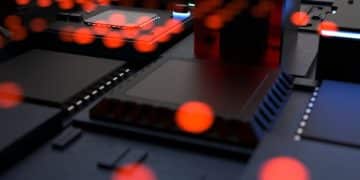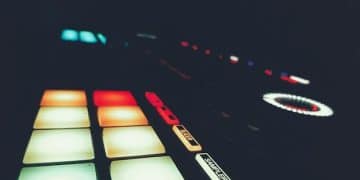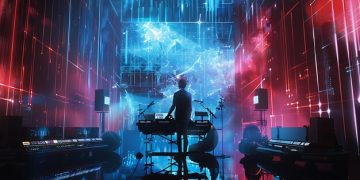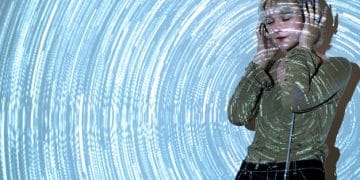AI’s Impact on Underground Artists in 2025: A Deep Dive
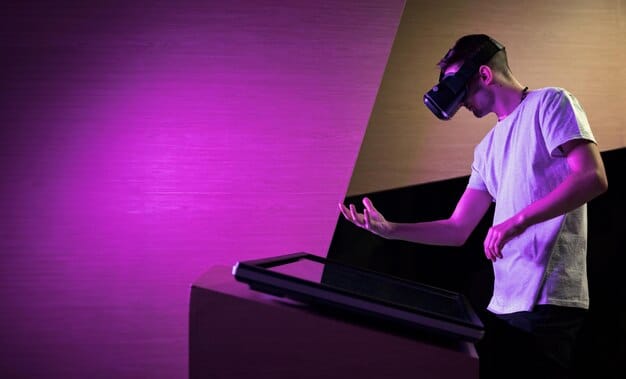
The emergence of AI-powered music creation tools by 2025 is poised to reshape the landscape for underground artists, offering unprecedented creative avenues and accessibility while presenting new challenges in originality, economic models, and competitive dynamics within the independent music scene.
As the year 2025 approaches, the music industry stands on the cusp of a profound transformation, driven largely by the accelerating development and widespread adoption of artificial intelligence. The question of How Will AI-Powered Music Creation Tools Impact Underground Artists in 2025? is not merely academic; it promises to redefine creativity, production, distribution, and the very concept of artistic ownership for those operating outside the mainstream.
The Dawn of AI in Music Production: A New Creative Horizon
The landscape of music creation is evolving at an unprecedented pace, with AI emerging as a transformative force. What once required extensive technical skills, expensive equipment, and vast amounts of time is now becoming accessible to a wider array of creators, including the vital community of underground artists. This shift isn’t just about automation; it’s about augmentation, offering tools that can assist in every stage of the creative process.
Accessibility and Democratization of Tools
One of the most immediate and tangible impacts of AI on underground artists will be the radical increase in accessibility to production capabilities previously out of reach. High-end studios and professional audio engineers are no longer absolute prerequisites for producing polished tracks. AI tools can handle tasks like mastering, mixing, and even composing basic melodic lines or percussion patterns, leveling the playing field for artists with limited resources.
- Reduced Barrier to Entry: AI lowers the financial and technical hurdles, allowing more diverse voices to emerge.
- Home Studio Empowerment: Artists can achieve near-professional quality from their bedrooms, fostering true independence.
- Rapid Prototyping: Ideas can be quickly sketch-produced and iterated upon, accelerating the creative workflow.
Creative Augmentation and Genre Blending
AI is not merely a replacement for human creativity; rather, it acts as a powerful assistant, capable of generating novel sounds, suggesting chord progressions, or even assisting in lyrical composition. For underground artists, this opens up unprecedented avenues for experimentation and genre-blending. Imagine an artist combining traditional folk instruments with AI-generated synth textures, or creating entirely new forms of soundscapes never before heard. This augmentation can spark fresh ideas, push artistic boundaries, and allow artists to explore sonic territories that might have been too complex or time-consuming to venture into manually. The true power lies in the collaborative potential between human ingenuity and artificial intelligence, leading to truly unique outputs.
The ability to generate variations of a theme or explore different orchestrations on demand means artists can quickly pivot and refine their vision, transforming mere concepts into fully realized pieces without substantial delays. This iterative process, facilitated by AI, can lead to a more robust and diverse output from the underground scene.
The adoption of AI will likely accelerate the evolution of existing genres and the birth of entirely new ones. Artists will be able to effortlessly cross-pollinate influences and discover unique sonic signatures that distinguish them in an increasingly crowded digital landscape. This might mean the emergence of micro-genres that accurately reflect niche cultural movements, unburdened by commercial constraints.
Challenges to Originality and Authenticity: The Core Dilemma
While the creative liberation offered by AI tools is undeniable, their widespread adoption also introduces complex challenges, particularly concerning originality, authenticity, and the very definition of artistic identity within the underground music scene. These issues strike at the heart of what it means to be an “artist” in an AI-assisted world.
Defining Originality in an AI-Generated Landscape
As AI models become more sophisticated, capable of generating indistinguishable music from human-made compositions, the concept of originality is bound to blur. If an AI can learn from vast datasets of existing music and create something new, yet derivative, how will underground artists differentiate their work? The underground scene often prides itself on raw, unfiltered expression, born from unique life experiences and genuine human emotion.
Will listeners perceive AI-assisted tracks as less authentic, even if they are technically perfect? This philosophical challenge will force artists and audiences alike to reconsider what constitutes “true” originality. It’s not just about the source of the sound, but the intent and human narrative behind it. For the underground, where authenticity can be currency, this is a significant hurdle.
- Sampling vs. Generation: The line between sampling existing tracks and generating new ones based on learned data becomes increasingly fine.
- Emotional Resonance: Can an AI truly replicate the raw emotion that defines many underground genres, or will this become the human artist’s exclusive domain?
- Attribution and Credit: How will collaboration with an AI be credited, ensuring proper recognition for human input?
The Risk of Homogenization
Another critical concern is the potential for homogenization. If many artists rely on the same AI models or widely available datasets, there is a risk that the output might begin to sound broadly similar, leading to what some might call “AI-core” music. The unique quirks, imperfections, and unexpected elements that often define underground music – elements that stem from genuine human experimentation and even error – could be smoothed out by AI’s pursuit of optimization. This could undermine the very diversity and distinctiveness that makes the underground scene so vibrant and appealing. Artists will need to find ways to inject their unique human fingerprint into AI-generated elements, ensuring their sound remains distinguishable. The challenge becomes using AI as a brush, not as a paint-by-numbers kit. Avoiding generic AI sounds will require individual artistic vision and careful curation of AI outputs.
The underground scene thrives on pushing boundaries and challenging conventions. If AI tools inadvertently lead to a safer, more predictable sonic palette, it could stifle the radical experimentation that has historically driven significant musical evolution. Artists must consciously strive to subvert the AI’s tendencies, using its powerful capabilities to achieve the unexpected rather than the optimized.
Economic Implications and Business Models
The economic ramifications of AI-powered music creation tools for underground artists are multifaceted, presenting both potential opportunities for new revenue streams and significant disruption to existing business models. The shift could redefine how independent artists earn a living from their craft.
Cost Reduction vs. Value Perception
On one hand, AI tools drastically slash production costs, allowing artists to bypass expensive studio time, session musicians, and often, even mixing and mastering engineers. This cost reduction is undoubtedly beneficial for artists operating on shoestring budgets. However, this accessibility could also lead to a saturation of the market, potentially lowering the perceived value of produced music. If everyone can create high-quality tracks with minimal investment, the unique selling proposition of “professionally produced” music might diminish, forcing artists to find new ways to stand out. The challenge will be translating efficiency into sustainable income.
The potential for a “race to the bottom” regarding pricing could emerge, where an overwhelming supply of AI-assisted content drives down listener willingness to pay for individual tracks or albums. This necessitates innovative approaches to monetization, moving beyond traditional sales and streaming.
New Monetization Avenues and Licensing
Despite the challenges, AI also opens doors to novel monetization strategies. Artists using AI tools might license their bespoke AI models or unique sound libraries they create using AI for other creators. Moreover, the ability to rapidly generate customized jingles, background music, or sound effects for various media (podcasts, videos, games) could become a significant source of income. This diversification of services beyond traditional music releases holds promise for financial stability.
- Custom Sound Design: AI tools allow for rapid creation of soundscapes for film, games, and digital content.
- AI Model Licensing: Artists could develop and license their own fine-tuned AI music generation models.
- Direct Fan Engagement: Reduced production costs free up resources for more direct fan engagement strategies, like exclusive content or live experiences.
The swiftness with which AI can produce variations or bespoke pieces means artists can fulfill a broader range of commercial briefs, enhancing their earning potential beyond just performing or selling records. This shifts the focus from mass appeal to targeted, high-value custom projects. Artists might also explore patronage models more extensively, where committed fans directly fund their work, valuing the unique human element over pure AI generation. This community-centric approach could become even more vital as the digital landscape becomes increasingly automated.
Navigating the Legal and Ethical Quandaries
The rapid evolution of AI-powered music creation tools has outpaced the development of legal and ethical frameworks, creating a complex minefield for underground artists navigating copyright, ownership, and fair use in 2025. These are not merely theoretical concerns but practical challenges that could impact an artist’s livelihood and creative freedom.
Copyright and Ownership of AI-Generated Content
A fundamental question arising from AI-generated music is: who owns the copyright? If an AI creates a piece of music, does the copyright belong to the artist who prompted the AI, the developers of the AI, or is it uncopyrightable? Current intellectual property laws were not designed for scenarios where an entity without legal personhood generates creative works. This ambiguity poses a significant risk for underground artists who rely on copyright to protect their unique sound and derive income from it. Without clear guidelines, disputes over ownership could become rampant, stalling innovation and discouraging genuine artistic expression.
The legal definition of “authorship” requires re-evaluation in the context of AI. Is the human merely a “user” or an “author”? The distinction will define who controls the rights to the AI-generated output. This will require robust legal precedents and potentially entirely new legislation. Furthermore, if an AI is trained on copyrighted material, how much output can be considered “derivative” before it infringes on existing works? This is a particular concern for underground artists who often push boundaries by recontextualizing sounds, a practice that might be misconstrued when AI is involved.
Ethical Use and Fair Compensation
Beyond legalities, ethical considerations abound. If AI is trained on vast datasets of existing music—much of it created by human artists—how will those artists be compensated or credited for their contribution to the AI’s “learning”? There’s a growing concern about “data washing,” where existing art is used to train AI without fair remuneration for the original creators. For underground artists whose work might be included in these datasets without their explicit consent or knowledge, this represents a significant ethical breach and a potential loss of future earnings.
- Data Licensing: Calls for ethical data sourcing for AI training and transparent licensing models.
- Attribution Protocols: Development of clear standards for crediting human creators whose work influences AI.
- Artist Rights Advocacy: Increased need for artist organizations to lobby for protective legislation against exploitative data practices.
The potential for AI to replicate an artist’s signature style without their permission is also an ethical nightmare. This could lead to a digital form of identity theft, where an underground artist’s hard-earned unique sound is appropriated and monetized by others, without any credit or compensation. Establishing clear ethical guidelines and legal safeguards will be paramount to fostering a fair and sustainable creative ecosystem. Without them, the very foundations of artistic integrity and economic viability could be destabilized for the underground community.
The Evolution of Fan Engagement and Community Building
In the underground music scene, fan engagement and community building are not mere marketing buzzwords; they are the lifeblood of an artist’s career. As AI-powered tools become more prevalent by 2025, they will profoundly reshape how underground artists connect with their audience and cultivate loyal communities, introducing both novel opportunities and new complexities.
Personalized Experiences and Niche Connections
AI offers unprecedented capabilities for hyper-personalization in fan engagement. Artists can leverage AI to analyze fan preferences, create tailored content recommendations, and even generate personalized messages or interactive experiences. Imagine an AI assisting an artist in writing a unique thank-you note to a top supporter, referencing their specific engagement history. This level of personalization can deepen the bond between artist and fan, fostering a stronger sense of loyalty and belonging within a niche community. For underground artists, who thrive on direct and authentic connections, this could be a game-changer in cultivating a dedicated following beyond mass appeal.
The ability to segment audiences with greater precision means that artists can craft highly specific campaigns or share content that resonates deeply with particular fan groups, rather than relying on a one-size-fits-all approach. This deepens the sense of individual recognition, a rare commodity in today’s digital noise.
Automation and the Human Touch Dilemma
While AI can automate routine communication tasks, allowing artists more time for creative work, it also presents a delicate balance. The underground scene often values the rawness and authenticity of direct artist-fan interaction. Over-reliance on AI for engagement could inadvertently strip away the genuine human connection that fans cherish, leading to a perception of artificiality. Artists will need to intelligently integrate AI, ensuring it enhances, rather than replaces, the personal touch. The challenge lies in distinguishing automated interactions from heartfelt human moments.
- Curated Engagement: AI identifies key fans for personalized, human-driven interactions.
- Interactive Content: AI-powered chatbots or generative tools for fan-artist interactive experiences.
- Community Management: AI can assist in identifying community trends and moderating online spaces, allowing artists to focus on direct connections.
Balancing efficiency with authenticity will be a critical skill for independent artists. Using AI to manage the logistical overhead of fan engagement, such as scheduling posts or analyzing engagement metrics, frees artists to dedicate their human energy to truly meaningful interactions like live streams, direct messages, or exclusive fan events. The focus should be on using AI to scale the human element, not to diminish it. This strategic integration can lead to a more vibrant and actively engaged underground community, powered by both technological efficiency and genuine artistic passion.
Shifting Landscapes of Performance and Live Music
The realm of live performance, a cornerstone of the underground music scene, is also ripe for transformation by AI-powered tools by 2025. While the traditional live experience relies heavily on human spontaneity and interaction, AI offers innovative pathways to enhance, extend, and even reimagine how underground artists bring their music to life beyond the studio.
Enhanced Live Performances and Visuals
AI can become an integral part of live shows, transforming them into more immersive and dynamic experiences. Imagine AI-driven visuals that react in real-time to the nuances of an artist’s performance, or an AI sound engineer autonomously mixing the live sound for optimal clarity in any venue. For underground artists with limited resources for complex productions, AI could democratize access to high-quality visual and sonic elements, making their live acts more captivating and distinctive. This fusion of human performance with intelligent augmentation promises a new era of sensory engagement.
The ability of AI to adapt and respond on the fly means that no two performances need to be identical, adding an element of unique unpredictability that audiences cherish. From dynamic lighting displays synchronized to intricate rhythm changes to generative art projected onto the stage that evolves with the mood of the music, AI can create truly unforgettable spectacles without large production crews.
Virtual Concerts and Extended Reality (XR)
The implications of AI extend beyond physical stages. AI-powered tools will be crucial in developing sophisticated virtual concerts and extended reality (XR) experiences. Underground artists could leverage AI to create hyper-realistic avatars, build interactive virtual worlds for performances, or even generate dynamic backdrops for live-streamed events. This expands their reach globally, allowing them to perform for audiences regardless of geographical limitations. Virtual venues could also offer unique opportunities for artistic expression, freed from the constraints of physical space and traditional stage setups.
- AI-Generated Stages: Creating unique, dynamically changing virtual stages for online performances.
- Interactive Audiences: Developing AI-powered interactive elements for virtual concert attendees.
- Immersive Storytelling: Using AI to craft narrative experiences around live performances in XR environments.
While the tactile energy of a physical underground gig remains irreplaceable, AI and XR offer a powerful supplementary platform for reaching and engaging fans. These virtual spaces can become laboratories for new forms of performance art, allowing artists to experiment with concepts that are impossible in the physical world. This opens up entirely new revenue streams and avenues for creative expression for artists struggling with traditional touring models, making live performance more accessible and adaptable to an evolving digital world.
Ultimately, the future of live music for the underground artist will likely be a hybrid model, seamlessly blending physical presence with innovative virtual experiences, all enhanced by the intelligent capabilities of AI.
| Key Point | Brief Description |
|---|---|
| ✨ Accessibility | AI lowers production barriers, democratizing music creation for independent artists. |
| ⚖️ Originality & Ethics | Challenges arise in defining authorship, copyright, and ensuring fair use of training data. |
| 💰 Economic Shifts | New monetization avenues emerge, alongside market saturation and pricing pressures. |
| 🤝 Fan Engagement | AI enables personalized fan experiences while requiring careful balance with human touch. |
Frequently Asked Questions About AI and Underground Music
▼
While AI tools will augment and streamline music creation, they are unlikely to fully replace human underground artists by 2025. AI primarily serves as a powerful assistant, automating tasks and suggesting creative avenues. The unique emotional depth, personal narrative, and raw spontaneity inherent in human artistry, especially in the underground scene, remain irreplaceable and are likely to be valued even more in an AI-assisted world.
▼
Maintaining originality with AI requires artists to view these tools as instruments for augmentation, not automation. Artists should focus on embedding their unique artistic vision, personal experiences, and distinct human touch into the AI-generated elements. Experimentation, conscious subversion of generic AI outputs, and blending AI contributions with traditional organic methods will be key to preserving a distinctive sound and authentic identity.
▼
AI tools offer significant economic benefits for underground artists, primarily through drastic cost reduction in production, mixing, and mastering. This democratizes high-quality output. Additionally, AI opens new monetization avenues, such as licensing custom AI-generated sound libraries, creating bespoke jingles for various media, and diversifying revenue streams beyond traditional music releases. It potentially frees up resources for more direct fan engagement strategies.
▼
The primary legal challenges revolve around copyright and ownership. It’s unclear who owns the intellectual property of music created by AI – the artist, the AI developer, or neither. There are also concerns about fair compensation for artists whose work is used to train AI models without explicit consent or remuneration. Existing intellectual property laws are struggling to keep pace with these rapid technological advancements, creating significant ambiguity for creators.
▼
AI will revolutionize live performances by enhancing visuals, automating sound engineering, and enabling immersive virtual concerts through extended reality (XR). Underground artists can leverage AI for dynamic, real-time reactive visuals and audio mixing, elevating their stage presence without prohibitive costs. AI also expands their reach globally via sophisticated virtual venues, allowing for unique artistic expressions freed from physical constraints, fostering a hybrid model of performance.
Conclusion
The trajectory for how AI-powered music creation tools will impact underground artists in 2025 is clearly one of profound transformation, oscillating between immense opportunity and considerable challenge. While AI promises to democratize creation, reduce costs, and unlock innovative artistic avenues previously unimaginable, artists must navigate complex questions of authenticity, ownership, and market saturation. The underground scene, with its inherent drive for individuality and direct connection, stands to gain greatly from these new tools if artists strategically integrate them without sacrificing their unique human voice. Ultimately, 2025 will be a pivotal year, marking the beginning of an era where success for underground artists may hinge not just on talent, but on their ability to harness AI intelligently and ethically, ensuring technology serves art, not the other way around.
